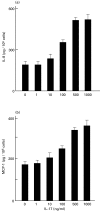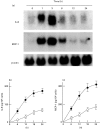Cooperation of interleukin-17 and interferon-gamma on chemokine secretion in human fetal intestinal epithelial cells
- PMID: 11472426
- PMCID: PMC1906093
- DOI: 10.1046/j.1365-2249.2001.01588.x
Cooperation of interleukin-17 and interferon-gamma on chemokine secretion in human fetal intestinal epithelial cells
Abstract
Interleukin (IL)-17 is a newly identified T cell-derived cytokine that can regulate the functions of a variety of cell types. In this study, we investigated the effects of IL-17 and interferon (IFN)-gamma on chemokine secretion in human fetal intestinal epithelial cells. IL-8 and monocyte chemoattractant protein (MCP)-1 secretion by the human fetal intestinal epithelial cell line, intestine-407, was evaluated by ELISA and Northern blot. The expression of IL-17 receptor (R) was analysed by a binding assay using [(125)I]-labelled IL-17. The activation of nuclear factor-kappa B (NF-kappa B), NF-IL6 and AP-1 was assessed by an electrophoretic gel mobility shift assay (EMSA). IL-17 induced a dose-dependent increase in IL-8 and MCP-1 secretion. The inducing effects of IL-17 on IL-8 and MCP-1 mRNA abundance reached a maximum as early as 3 h, and then gradually decreased. IL-17 and IFN-gamma synergistically increased IL-8 and MCP-1 secretion and mRNA abundance. IFN-gamma induced a weak increase in IL-17 R mRNA abundance, and incubation with IFN-gamma for 24 h enhanced [(125)I]-labelled IL-17-binding by 2.4-fold. IL-17 rapidly induced the phosphorylation and degradation of I kappa B alpha molecules, and the combination of IL-17 and IFN-gamma induced a marked increase in NF-kappa B DNA-binding activity as early as 1.5 h after the stimulation. Furthermore, this combination induced an increase in NF-IL-6 and AP-1 DNA-binding activity. In conclusion, it becomes clear that IL-17 is an inducer of IL-8 and MCP-1 secretion by human fetal intestinal epithelial cells. The combination of IL-17 with IFN-gamma synergistically enhanced chemokine secretion. These effects of IL-17 and IFN-gamma might play an important role in the inflammatory responses in the intestinal mucosa.
Figures






References
-
- Miller MD, Krangel MS. Biology and biochemistry of the chemokines: a family of chemotactic and inflammatory cytokines. Crit Rev Immunol. 1992;12:17–46. - PubMed
-
- Baggiolimi M, Dewald B, Moser B. Interleukin-8 and related chemotactic cytokines-CXC and CC chemokines. Adv Immunol. 1994;55:97–179. - PubMed
-
- Eckmann L, Jung HC, Schurer-Maly C, et al. Differential cytokine expression by human intestinal epithelial cell line: regulated expression of interleukin 8. Gastroenterology. 1993;105:1689–97. - PubMed
-
- Fossiez F, Banchereau J, Murry R, van Kooten C, Garrone P, Lebecque S. Interleukin-17. Intern Rev Immunol. 1998;16:541–51. - PubMed
-
- Yao Z, Painter SL, Fanslow WC, et al. Human IL-17: a novel cytokine derived from T cells. J Immunol. 1995;155:5483–6. - PubMed
Publication types
MeSH terms
Substances
LinkOut - more resources
Full Text Sources
Miscellaneous

